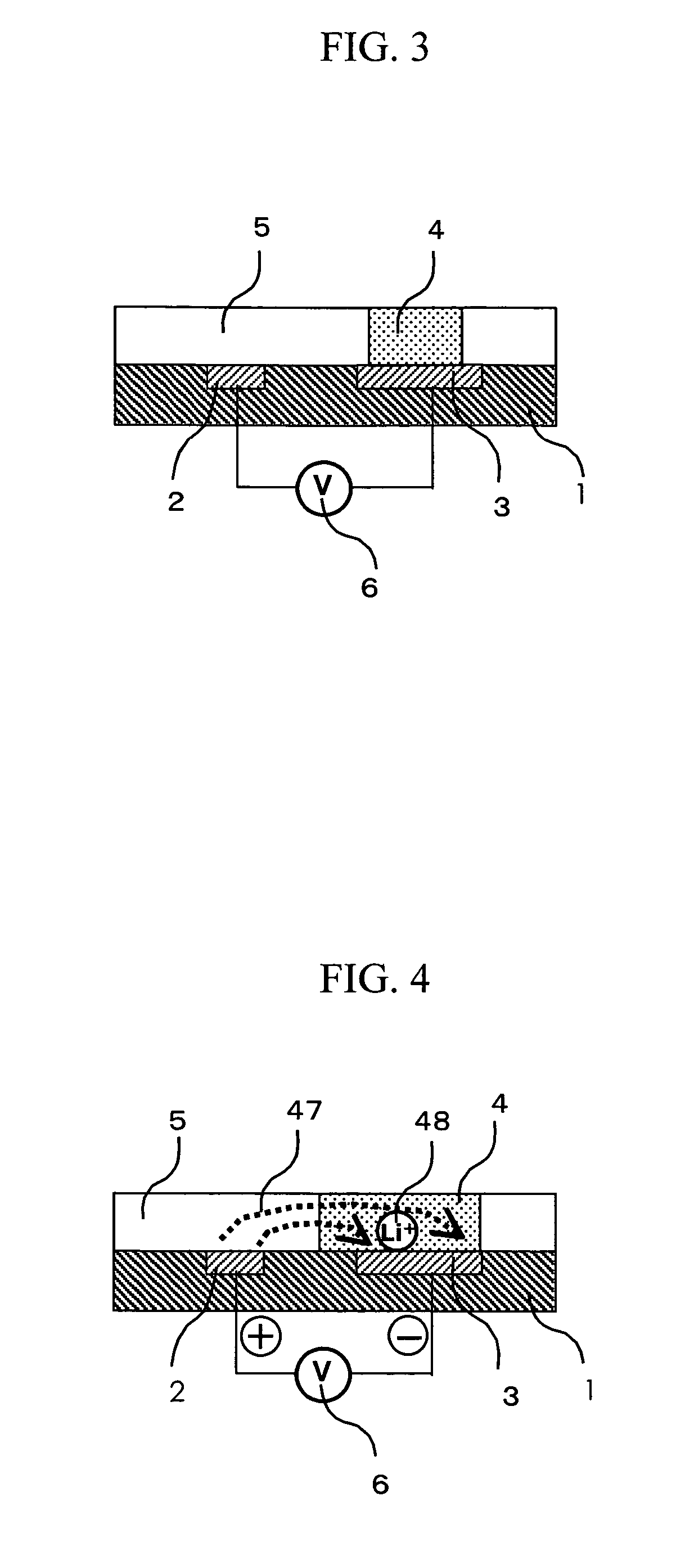Electrochromic device
a technology of electrochromic layer and electrode, applied in non-linear optics, instruments, optics, etc., can solve the problems of high power consumption, inability to obtain color density corresponding to the thickness of the electrochromic layer, and inability to easily achieve color density. , to achieve the effect of improving color density, simple structure and small thickness
- Summary
- Abstract
- Description
- Claims
- Application Information
AI Technical Summary
Benefits of technology
Problems solved by technology
Method used
Image
Examples
example 1
(Construction and Manufacture)
[0080]FIG. 11 is a diagram showing a process for manufacturing the electrochromic device of the invention according to a first method.
[0081]A 150 nm thick electrochromic layer 366 of a poly(3,4-ethylene dioxythiophene)-polystyrene sulfonic acid complex was formed by a photolithography process on a 3 cm square, 1 mm thick insulating glass substrate 361 carrying an ITO electrode 363 and an ITO electrode 364 of width 5 mm and thickness 50 nm.
[0082]A solution of composition 20 wt % polyethylene oxide having a molecular weight of 1 million, 2 wt % lithium perchlorate and 78 wt % tetrahydrofuran was then spin-coated on the remaining exposed part of the substrate at 1000 rpm for 60 seconds to form a 150 nm thick electrolyte layer 368, and an electrochromic device was thus produced.
(Operation of Electrochromic Device)
[0083]FIG. 12 is a diagram of the produced device viewed from the upper part of the electrolyte layer. When a voltage of 6V was applied to the fir...
example 2
[0094]An electrochromic device having the first structure according to the invention was manufactured in exactly the same way as in Example 1, except that tungstic oxide was used for the electrochromic compound, and a photolithography process and RF magnetron sputtering were used to form the electrochromic layer. When this device was connected to a power supply as in Example 1 and a voltage was applied between the electrodes, reversible coloring could be performed.
[0095]If the device was manufactured using iridium oxide, nickel oxide, titanium oxide or vanadium pentoxide for the electrochromic compound, reversible coloring could still be performed.
example 3
[0096]This example relates to a device panel wherein the pixels in the electrochromic device of the invention are arranged in a matrix, and to an information display using same.
[0097]A matrix display panel and device using 12 electrochromic devices, which are shown in FIGS. 15 and 16, were manufactured by the following methods. The materials used are the same as those of Example 1. FIG. 15 shows the construction of the display panel and FIG. 16 shows the construction of the information display.
[0098]A silicon thin film is formed on a substrate 463, an integrated circuit comprising a pixel driver region 464, buffer amplifier 465 and gate driver region 466 is provided thereupon, and the whole is connected to an image information display panel 461 comprising pixels 462. 467 is a shift register region and 468 is a data driver region.
[0099]The method of manufacturing the display panel is as follows.
[0100]A signal wire 439 and gate line 440 were manufactured on a glass substrate. Next, 12...
PUM
| Property | Measurement | Unit |
|---|---|---|
| distance | aaaaa | aaaaa |
| thickness | aaaaa | aaaaa |
| ion conductivity | aaaaa | aaaaa |
Abstract
Description
Claims
Application Information
 Login to View More
Login to View More - R&D
- Intellectual Property
- Life Sciences
- Materials
- Tech Scout
- Unparalleled Data Quality
- Higher Quality Content
- 60% Fewer Hallucinations
Browse by: Latest US Patents, China's latest patents, Technical Efficacy Thesaurus, Application Domain, Technology Topic, Popular Technical Reports.
© 2025 PatSnap. All rights reserved.Legal|Privacy policy|Modern Slavery Act Transparency Statement|Sitemap|About US| Contact US: help@patsnap.com



